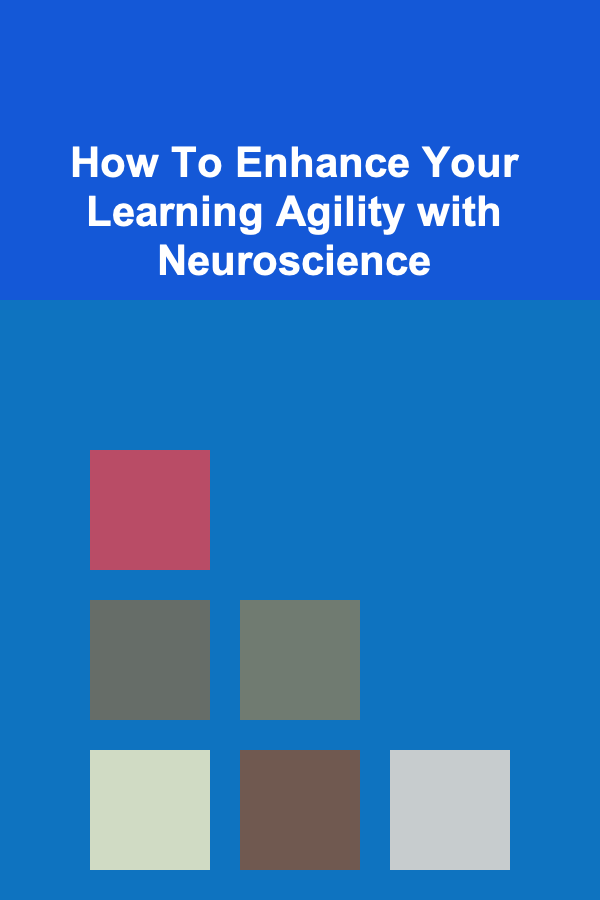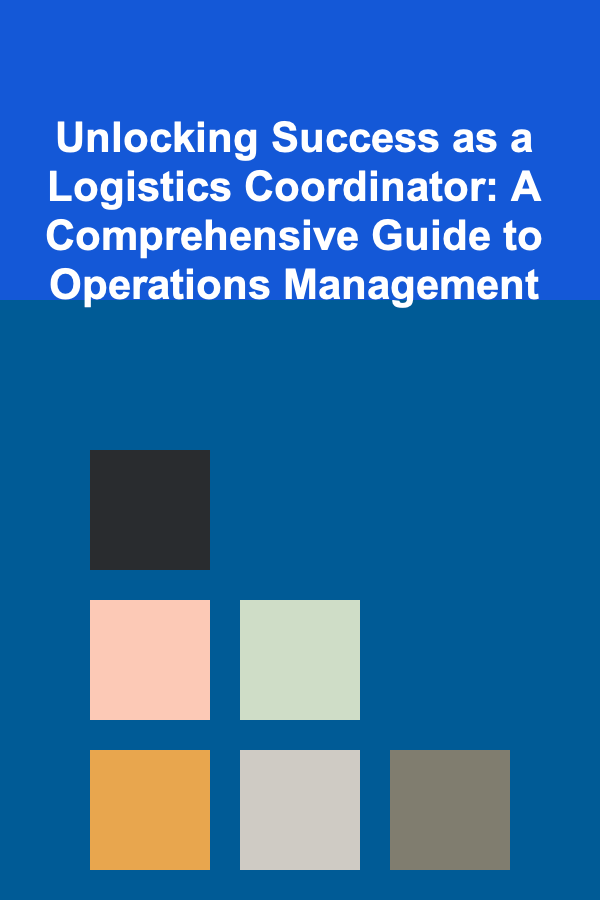
How To Enhance Your Learning Agility with Neuroscience
ebook include PDF & Audio bundle (Micro Guide)
$12.99$11.99
Limited Time Offer! Order within the next:

In the fast-paced world we live in, the ability to quickly learn and adapt to new information, skills, or environments is invaluable. This ability, known as learning agility, is critical not only for personal development but also for professional success in dynamic fields. Interestingly, learning agility isn't solely about being fast; it involves the capacity to embrace new experiences, make quick decisions, and apply knowledge effectively. Neuroscience provides a window into understanding how our brain processes, stores, and retrieves information, offering valuable insights into how we can enhance our learning agility.
In this article, we will explore the concept of learning agility from a neuroscience perspective and provide practical strategies for boosting this crucial skill. We'll dive into the science of the brain, how learning happens at the neurological level, and what you can do to enhance your learning capacity.
What is Learning Agility?
Before diving into the neuroscience behind learning agility, it's essential to understand what this concept entails. Learning agility refers to the ability to learn from experience and apply that learning to perform successfully in new and changing situations. It involves several facets:
- Mental Flexibility: The ability to adapt your thinking when faced with new or unexpected situations.
- Curiosity: A desire to learn and explore new concepts, skills, or perspectives.
- Risk-taking: Willingness to step out of your comfort zone and experiment with new methods or ideas.
- Reflection: The ability to look back on past experiences and extract valuable lessons for future endeavors.
Unlike traditional learning, which tends to be linear and structured, learning agility is dynamic and involves rapidly processing and applying information. Neuroscience can shed light on how our brain is wired to develop these skills and how we can intentionally train it to become more agile in learning.
The Brain and Learning
To understand how neuroscience enhances learning agility, it's crucial to first grasp how the brain processes learning. Our brain is an incredibly complex organ, with around 86 billion neurons, each forming thousands of connections called synapses. These neurons communicate with each other through electrical signals, allowing us to process information and form memories.
The key areas of the brain involved in learning include:
1. The Hippocampus
The hippocampus is a small, seahorse-shaped structure located in the medial temporal lobe of the brain. It plays a crucial role in the formation of new memories and spatial navigation. When we learn something new, the hippocampus helps encode this information and store it in long-term memory. This process is known as synaptic plasticity, which involves the strengthening or weakening of synaptic connections between neurons. The more you repeat a task or expose yourself to new information, the stronger these connections become, leading to improved retention and recall.
2. The Prefrontal Cortex
Located at the front of the brain, the prefrontal cortex is responsible for higher cognitive functions such as decision-making, problem-solving, and planning. It plays a significant role in learning agility by helping you assess new information, make decisions based on prior knowledge, and adapt strategies when things aren't going as planned. This part of the brain is also responsible for executive functions, such as working memory, cognitive flexibility, and inhibitory control, all of which are crucial for learning in dynamic environments.
3. The Amygdala
The amygdala is a small almond-shaped structure involved in processing emotions, particularly fear and pleasure. Although it is primarily associated with emotional responses, the amygdala also influences learning by attaching emotional significance to experiences. Positive emotions (like excitement or satisfaction) enhance the brain's ability to retain information, while negative emotions (like stress or fear) can interfere with learning. Understanding this relationship between emotion and learning can help individuals cultivate environments that foster positive emotions to improve learning outcomes.
4. The Striatum
The striatum is part of the basal ganglia, a group of structures involved in motor control and reward processing. The striatum helps reinforce learning by linking experiences to rewards. When we learn something new and receive a reward (either intrinsic or extrinsic), the brain releases dopamine, a neurotransmitter associated with pleasure and motivation. This positive reinforcement encourages us to repeat the behavior, thereby strengthening our learning pathways.
How Neuroscience Enhances Learning Agility
Now that we have a basic understanding of how the brain processes learning, let's explore how neuroscience can enhance learning agility. The key to enhancing learning agility lies in understanding how to leverage brain plasticity, create optimal learning environments, and train the brain to be more adaptable and efficient.
1. Harnessing Neuroplasticity
Neuroplasticity refers to the brain's ability to reorganize itself by forming new neural connections throughout life. The more you challenge your brain with new experiences, the more you stimulate neuroplasticity. For example, learning a new language or a complex skill activates the hippocampus and prefrontal cortex, encouraging the brain to form new connections. Over time, these connections become stronger and more efficient, leading to improved learning agility.
To enhance neuroplasticity, consider the following strategies:
- Practice Deliberate Learning: Focus on areas where you feel challenged or unfamiliar. Deliberate practice forces the brain to adapt and form new connections.
- Engage in Complex Tasks: Engage in tasks that require critical thinking, problem-solving, and creativity. The more complex the task, the more the brain is forced to grow and adapt.
- Stay Consistent: The brain's ability to change and grow is highly influenced by repetition. Regular practice, even for short periods, is more effective than cramming.
2. Improving Cognitive Flexibility
Cognitive flexibility is the brain's ability to switch between different thoughts, concepts, or actions. This is essential for learning agility because it allows you to adapt to new information or unexpected challenges. The prefrontal cortex is the key player in cognitive flexibility, and certain practices can help enhance this ability.
To improve cognitive flexibility, you can:
- Challenge Your Thinking: Engage in activities that force you to see things from multiple perspectives. For example, reading diverse genres of books or solving puzzles that require unconventional thinking can increase cognitive flexibility.
- Learn New Skills: Pursue new activities or skills that stretch your mind, such as learning a new language, taking up a musical instrument, or experimenting with new hobbies.
- Practice Mental Shifting: Try switching between tasks or ideas more frequently, or practice tasks in different sequences. This forces the brain to adapt and grow its flexibility.
3. Managing Stress and Emotions
As mentioned earlier, the amygdala is responsible for processing emotions, which significantly impact learning. Stress, fear, and anxiety can disrupt the brain's ability to learn by impairing memory and attention. On the other hand, positive emotions can enhance learning by making the process more enjoyable and motivating.
To manage stress and optimize emotional states for learning, try these techniques:
- Mindfulness and Meditation: These practices help reduce stress and anxiety by calming the amygdala and enhancing attention. Regular mindfulness practice has been shown to improve cognitive function, emotional regulation, and memory retention.
- Positive Reinforcement: Reward yourself for small achievements. This could be as simple as acknowledging progress or giving yourself a break after completing a challenging task. Positive reinforcement releases dopamine, strengthening the connection between effort and reward.
- Physical Exercise: Regular physical activity boosts mood and cognitive function. Exercise increases blood flow to the brain, promotes neurogenesis (the growth of new neurons), and supports overall brain health.
4. Optimizing Sleep
Sleep plays a critical role in consolidating memories and enhancing learning. During sleep, the brain processes and strengthens the information learned during the day, particularly in the hippocampus. Poor sleep can interfere with these processes, leading to impaired learning and reduced cognitive function.
To improve your learning agility through sleep:
- Prioritize Quality Sleep: Aim for 7-9 hours of uninterrupted sleep each night. Focus on creating a sleep-friendly environment by reducing distractions and establishing a consistent bedtime routine.
- Use Sleep for Consolidation: If you're learning something new, consider taking a short nap after studying. Research has shown that naps can enhance memory consolidation and improve learning outcomes.
- Avoid Sleep Deprivation: Lack of sleep impairs the prefrontal cortex, hindering decision-making, problem-solving, and cognitive flexibility. Aim for consistent and sufficient sleep to ensure your brain is functioning at its best.
5. Adopting a Growth Mindset
A growth mindset, as proposed by psychologist Carol Dweck, refers to the belief that intelligence and abilities can be developed through effort and learning. People with a growth mindset are more likely to embrace challenges, persist through difficulties, and see failure as an opportunity for growth.
To cultivate a growth mindset:
- Embrace Challenges: Instead of avoiding difficult tasks, approach them as opportunities to grow. Challenges stimulate the brain to form new connections and enhance learning agility.
- View Failures Positively: Instead of seeing failure as a setback, view it as a learning opportunity. Each failure is a step toward mastery.
- Stay Open to Feedback: Constructive feedback helps you identify areas of improvement and adapt your learning strategies. Actively seek feedback and use it to grow.
Conclusion
Learning agility is a critical skill that can enhance both personal and professional growth. By understanding the neuroscience behind learning and applying strategies that leverage brain function, neuroplasticity, and emotional regulation, we can improve our ability to learn, adapt, and thrive in dynamic environments. Embrace the brain's capacity for change, stay curious, and cultivate practices that promote cognitive flexibility, and you will be well on your way to enhancing your learning agility for years to come.

How to Create a Membership Recruitment Checklist for Your Organization
Read More
How to Plan a Stress-Free Cocktail Party at Home
Read More
How to Research Cryptocurrency Security Best Practices
Read More
How to Use Binders to Organize Your Favorite Recipes
Read More
Unlocking Success as a Logistics Coordinator: A Comprehensive Guide to Operations Management
Read More
10 Tips for Boosting Sales with Limited-Time Offers
Read MoreOther Products

How to Create a Membership Recruitment Checklist for Your Organization
Read More
How to Plan a Stress-Free Cocktail Party at Home
Read More
How to Research Cryptocurrency Security Best Practices
Read More
How to Use Binders to Organize Your Favorite Recipes
Read More
Unlocking Success as a Logistics Coordinator: A Comprehensive Guide to Operations Management
Read More